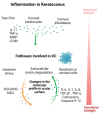Omics in Keratoconus: From Molecular to Clinical Practice
- PMID: 40217908
- PMCID: PMC11990029
- DOI: 10.3390/jcm14072459
Omics in Keratoconus: From Molecular to Clinical Practice
Abstract
Keratoconus (KC) is a progressive ocular disorder marked by structural and functional alterations of the cornea, leading to significant visual impairment. Recent studies indicate that these corneal changes are linked to molecular and cellular mechanisms that disrupt and degrade the extracellular matrix. This degradation is influenced by proteinases that contribute to a loss of homeostasis and an imbalance in the antioxidant/oxidative state within the cornea, fostering oxidative stress, inflammation, and apoptosis. Although these biological processes have been identified primarily through molecular biology research, omics technologies have significantly advanced our understanding of the physiological and pathological phenomena associated with KC. Omics studies encompassing genomics, transcriptomics, proteomics, epigenomics, and metabolomics, have emerged as critical tools in elucidating the complex biological landscape of various diseases, including ocular conditions. The integrative application of these studies has demonstrated their potential in personalizing medicine across diverse fields such as oncology, neurology, and ophthalmology. This review aims to describe findings from omics research applied to keratoconus, highlighting the genomic, transcriptomic, proteomic, epigenomic, and metabolomic aspects derived from ocular and other biological samples. Notably, the molecular insights gained from these studies hold promise for identifying biomarkers of keratoconus, which could enhance diagnostic accuracy and therapeutic strategies. The exploration of these biomarkers may facilitate improved management and treatment options for patients, contributing to personalized care in keratoconus management.
Keywords: exposome; genetics; inflammation; keratoconus; omics; transcriptomic.
Conflict of interest statement
The authors declare no conflicts of interest.
Figures


References
-
- Valdez-García J.E., Sepúlveda R., Salazar-Martínez J.J., Lozano-Ramírez J.F. Prevalence of keratoconus in an adolescent population. Rev. Mex. Oftalmol. 2014;88:95–98. doi: 10.1016/j.mexoft.2014.03.002. - DOI
-
- Galvis V., Tello A., Jaramillo J.A., Gutierrez A.J., Rodriguez L., Quintero M.P. Prevalence of keratoconus patients who consulted with a desire refractive surgery in ophthalmology center reference Bucaramanga, Colombia. Rev. Soc. Colomb. Oftal. 2011;44:129–134.
Publication types
LinkOut - more resources
Full Text Sources

